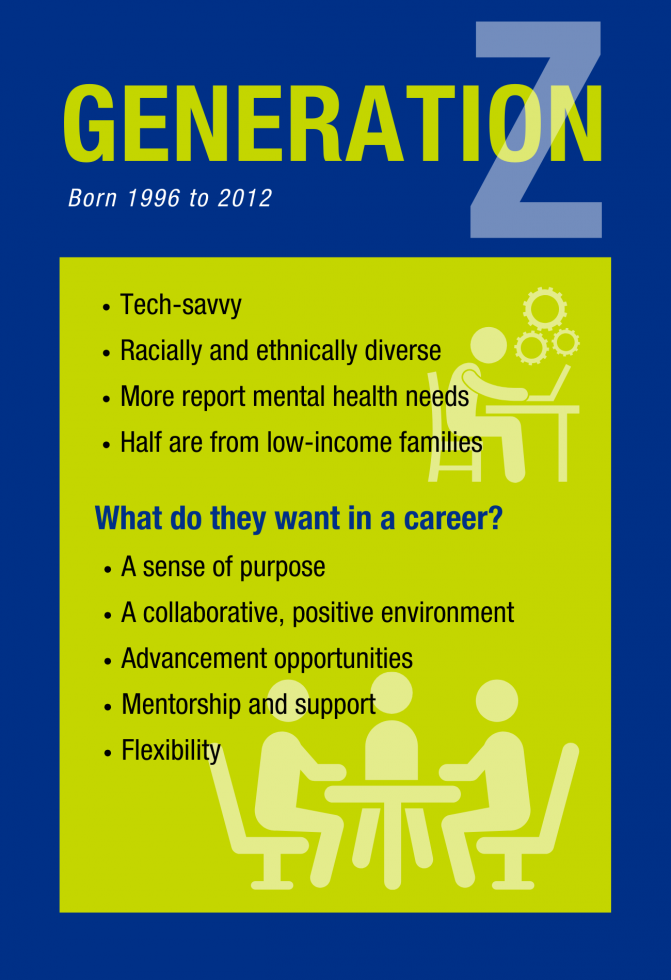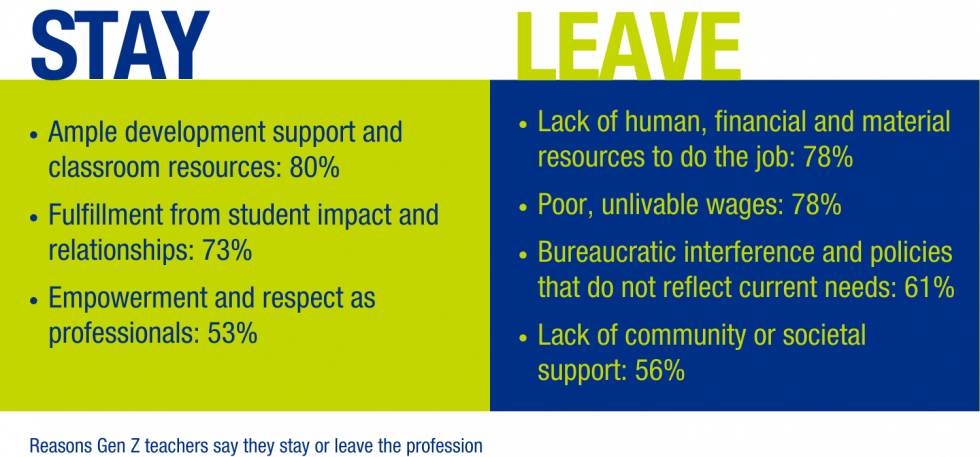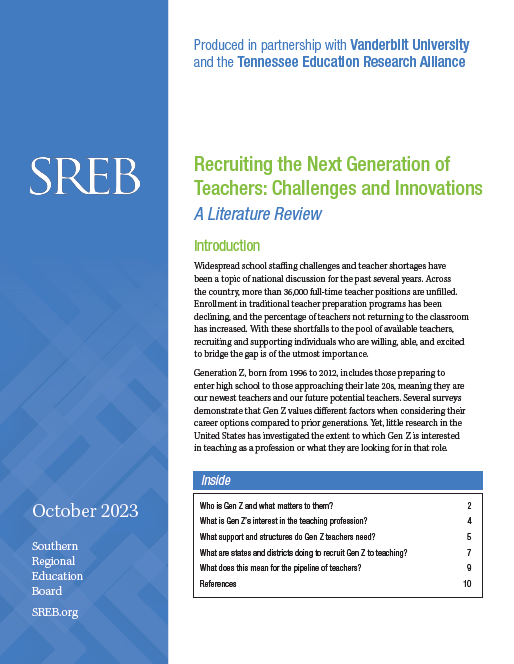The Next Generation of Teachers
A Study of Generation Z’s Interest in the Teaching Profession
We depend on Generation Z to fill the growing number of teaching vacancies. Partnering with researchers at Vanderbilt University’s Peabody College of Education, SREB studied data in Kentucky and Tennessee for insight into Gen Z and their interest in the teaching profession. This online report features six findings with interactive charts.
Insight for Leaders
Introduction
The teaching profession is suffering from record low interest and a declining number of graduates moving into education. At the same time, retirements and vacancies are increasing. So society relies heavily on new generations to fill employment gaps.
Generation Z, born between 1996 and 2012, is coming of age through life-altering world events, always-on technology, and social and political unrest. What do members of this generation want and need as they enter the workforce?
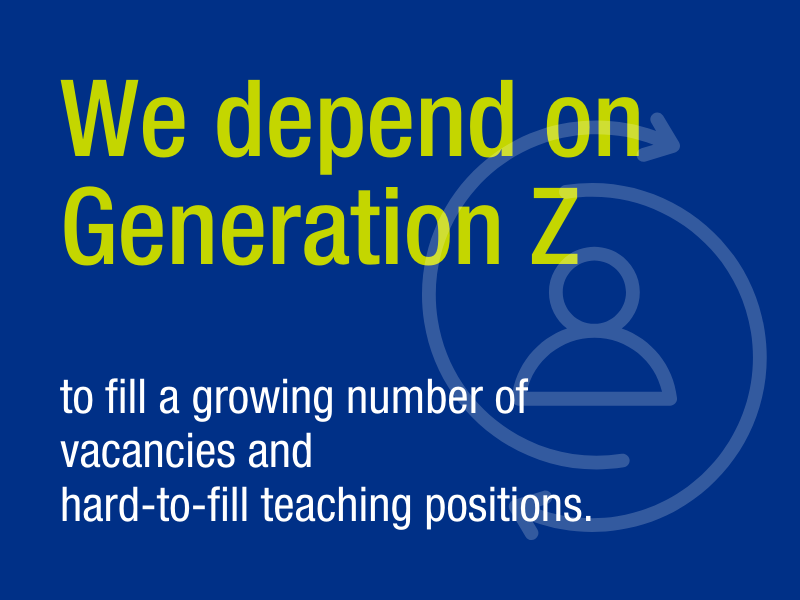 The Southern Regional Education Board and researchers at Vanderbilt University’s Peabody College of Education conducted a mixed-methods study concentrating on two data-rich Southern states — Kentucky and Tennessee. Our analysis uses ACT student survey data and state data on educators, supplemented by interviews with Gen Z teacher candidates and educators from both states.
The Southern Regional Education Board and researchers at Vanderbilt University’s Peabody College of Education conducted a mixed-methods study concentrating on two data-rich Southern states — Kentucky and Tennessee. Our analysis uses ACT student survey data and state data on educators, supplemented by interviews with Gen Z teacher candidates and educators from both states.
The goal: Begin to answer the question of whether Gen Z has less interest in impacting children or merely a dwindling interest in teaching careers ─ and why.
This study aims to describe how interest in a career in education has shifted. It examines high school students’ aspirations to pursue a career in teaching as well as recent trends in preparation pathways for newly hired educators. Six major findings are outlined below.
We depend on Generation Z to fill a growing number of vacancies and hard-to-fill teaching positions. Our research aims to inform education leaders and policymakers on how to make teaching an attractive profession with the security, support and sustainability Gen Z desires.
The State of Teacher Recruitment
Recruiting and retaining teachers is a major issue, not only for educational attainment but for states’ overall workforce and economy.
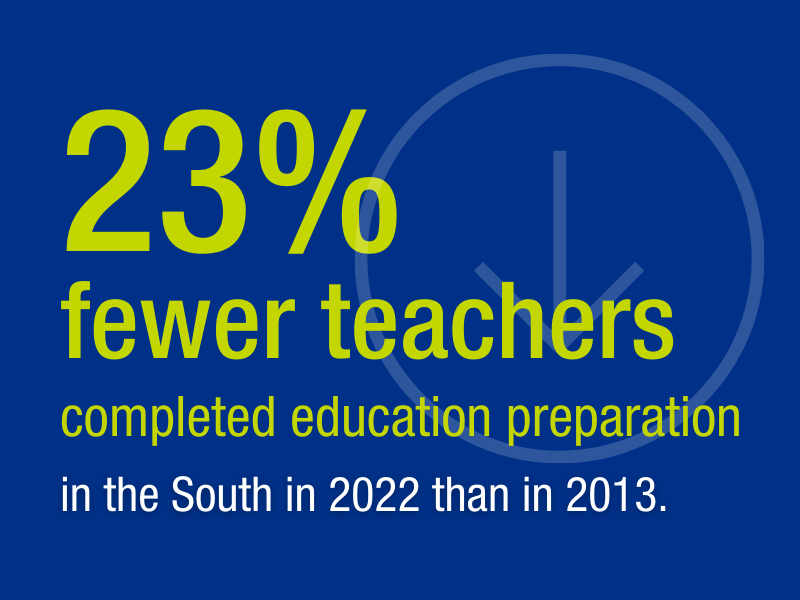 Fifteen Southern states saw declines in the number of new teacher candidates graduating from preparation programs: 23% fewer teachers completed educator preparation in 2022 than in 2013 across those states. That’s more than 16,000 fewer teacher candidates prepared.
Fifteen Southern states saw declines in the number of new teacher candidates graduating from preparation programs: 23% fewer teachers completed educator preparation in 2022 than in 2013 across those states. That’s more than 16,000 fewer teacher candidates prepared.
According to SREB’s analysis of data in the South, up to 30% of the total teacher workforce is inexperienced, uncertified or teaching out of field.
The United States faces persistent challenges in filling vacancies and preventing shortages. Recent data from the School Pulse Panel and Principal Survey found that 37% of public schools reported at least one teaching vacancy in October 2023.
Since the Great Recession of the late 2000s, every state in the South has faced a growing teacher shortage, with critical shortages in at least three subject areas. Some face shortages in all grades and subjects. Schools in the South, schools with higher percentages of students whose families are living in poverty, and schools with greater percentages of students of color are more likely to have teacher vacancies.
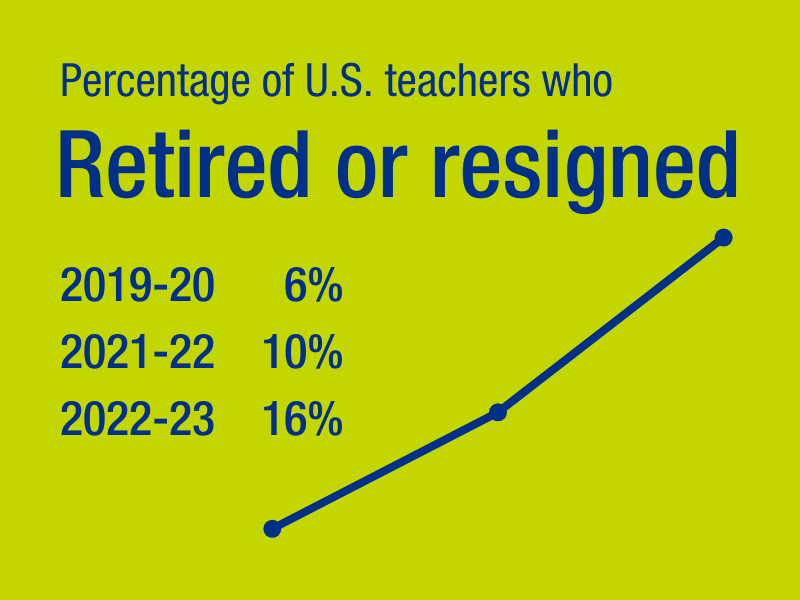 Retirements and turnover are compounding shortages. A RAND survey of district leaders shows that the percentage of teachers in the U.S. who retired or resigned increased from 6% in 2019-20 to 10% in 2021-22, reaching 16% in 2022-23. The COVID-19 pandemic likely exacerbated concerns with teacher recruitment, as it appears to have influenced undergraduate students’ interest in and perceptions of teaching in negative ways.
Retirements and turnover are compounding shortages. A RAND survey of district leaders shows that the percentage of teachers in the U.S. who retired or resigned increased from 6% in 2019-20 to 10% in 2021-22, reaching 16% in 2022-23. The COVID-19 pandemic likely exacerbated concerns with teacher recruitment, as it appears to have influenced undergraduate students’ interest in and perceptions of teaching in negative ways.
Parents’ desire for their children to pursue teaching as a career has fallen by more than 30% since 2010. In the same period, the number of graduates from teacher preparation programs also decreased precipitously, by a third the rate of early decades. The number of undergraduate degrees in education has been in decline since 2005.
About K-12 Schools in KY and TN
|
Kentucky Teacher Workforce 2021-22 |
Tennessee Teacher Workforce 2021-22 |
|---|---|
|
630,000 students |
970,000 students |
|
1,400+ schools |
1,800+ schools |
|
171 school districts |
147 school districts |
|
Majority of school districts are rural |
Majority of school districts are rural |
|
73.5% of students are white 11% are Black or African American 8.5% are Hispanic or Latino 7% identify as another ethnic or racial group |
60% of students are white 24% are Black or African American 13% are Hispanic or Latino 3% identify as Asian |
|
60% of students are economically disadvantaged |
30% of students are economically disadvantaged |
|
43,500 full-time teachers |
68,000 full-time teachers |
|
77.5% of teachers are female |
79.9% of teachers are female |
|
95.2% are white |
84.9% of teachers are white |
|
Average student-teacher ratio is 15 students to 1 teacher |
Average student-teacher ratio is 14 students to 1 teacher |
|
Nearly 75% of the teacher workforce has a master’s degree or higher. |
64% of the educator workforce has a master’s degree or higher. 13.7% of teachers have three years of experience or less |
|
Average teacher retention is 80% |
Average teacher retention is 92% |
Who is Gen Z?
Gen Z’s Interest in Teaching
- Gen Z is less interested in teaching as a career than earlier generations.
- Enrollment in educator preparation programs began declining in 2010 with the end of the Millennial generation and has hit historic lows following Gen Z’s entrance into higher education starting in 2014.
The Environment Gen Z Expects
- Gen Z teachers are entering schools where educators’ confidence in the teaching profession is low. Gen Z teachers need positive school environments and access to mental health support.
- They need training for teaching diverse learners.
- Gen Z teachers seek advancement opportunities at work.
- They value collaboration, flexibility and ongoing mentorship.
- Gen Z teachers expect to use instructional technology in their classrooms. Educator preparation programs need to model how to responsibly use technology, particularly mobile, in instruction.
Find more in our review of the literature on Gen Z and interest in teaching.
Finding 1: Interest in an education career among high school students declined steadily since 2013.
Interest in pursuing an education career declined across eight Southern states.
The decade-long downward trend is similarly steep for high school students’ interest in studying education in college, according to analysis of ACT data. Declining interest in teaching among high school students shrinks an already small pool of those interested in the profession.
Hover to see more-specific data in the charts below.
High school students are increasingly undecided about their intended college majors.
A growing proportion in both Tennessee and Kentucky are undecided about both their college major plans and future occupations. Starting in 2021, students most often selected “undecided” as their intended major, surpassing health sciences.
Students who are more certain about their college majors are signaling an interest in the health sciences, business, engineering and science.
On average, education-related majors are the sixth most popular intended major.
These graphs include data on high school students who enrolled in college. Students may select from 294 major or occupation choices in 18 different major or occupation groups.
Finding 2: Students who plan to major in education and express interest in an education career are predominantly white and female and have lower ACT scores.
Female high school students are much more likely to indicate they plan to major in education than male students in both states.
The pool of students who intend to major in education has become slightly more female.
Hover to see more-specific data in the charts below.
White high school students are much more likely to indicate they plan to major in education than students of color in both states.
Interested students remain predominantly white, mirroring the current teacher workforce. This data is not promising for efforts to diversify the teaching workforce.
Interest in teaching declined among urban, suburban and rural students, yet rural students are more likely to be interested in teaching.
Students from more rural areas and towns are more likely to be interested in teaching. However, interest in majoring and working in education declined among students across all locale types.
Students intending to major in education have lower ACT scores than their peers who enroll in postsecondary education.
The average ACT scores of high school students intending to major in education in both Kentucky and Tennessee are slightly lower than students selecting other intended majors and careers.
This trend persists over time. Across the last decade, students intending to major in education had an average ACT composite score of 21.2 in Tennessee and 21.5 in Kentucky. For comparison, undecided majors had average ACT scores of 22.7 in Tennessee and 22.4 in Kentucky.
Male students in Kentucky and Tennessee who are interested in an education career are more likely to indicate intent to major in something other than education.
A greater share of male than female students students say they intend to major in something other than education (25% in 2022), even if they intend to work in education. These students most commonly indicate that they intend to major in the arts or business.
This suggests that analyses focused solely on students who enroll, or plan to enroll in education programs may miss an important population of potential teachers who do not major in education, particularly among male students.
Finding 3:
Enrollment in high school introductory teaching courses in Tennessee and Kentucky is increasing.
Access to Tennessee Teaching as a Profession courses expanded and student enrollment increased.
Tennessee school districts across the state offer Teaching as a Profession courses for high school students interested in becoming educators. Originally designed as a three-course sequence, they prepare learners for postsecondary credentials and careers as educators. Students can participate in an internship to gain hands-on experience.
Any teacher who has completed an educator preparation program and has a current practitioner or professional educator license covering grades 6 to12 may teach these courses.
Since 2018, both Teaching as a Profession course offerings and enrollment have been on the rise. In the 2021-22 school year, 5% of female students and 2% of male students across the state enrolled in at least one of the courses. Enrollees were mostly female (83% on average since 2010).
However, male enrollment in the courses has grown in recent years, reaching 21% in 2022. In schools that offer the courses, about 5% of students have enrolled over time.
Hover to see more-specific data in the charts below.
Enrollment rates among Tennessee students increased over time across racial and ethnic groups.
While most students enrolled in Teaching as a Profession courses are white (74%, on average between 2010 and 2022), the demographics of students enrolling in the courses has diversified slightly over time.
Enrollment rates have increased for all students across student racial and ethnic groups, with Black students seeing the highest enrollment rate increase. As the state continues to expand course offerings and invest in registered teacher apprenticeship models, participation in these courses is likely to grow. Other students of color make up less than 3% of total student enrollment in 2022-23.
Teaching and Learning courses in Kentucky experienced a similar growth in enrollment. Kentucky first began offering the courses in 2018, and enrollment more than doubled in three years from about 1,000 students to over 2,200 in 2021. In the 2020-21 school year, 82% of enrollees were female and 75% were white.
Finding 4:
Half of early-career teachers in Tennessee formed aspirations to become educators before college.
Half of early-career teachers started college with plans to pursue a career in education. The Tennessee Educator Survey suggests many current teachers formed aspirations to pursue a career in education before college: About 70% of early-career teachers in Tennessee entered college considering a career in education.
Hover to see more-specific data in the charts below.
Forty-two percent of early career teachers thought about becoming a teacher before finishing high school, while almost half decided on their career path after high school.
This suggests that early exposure to teaching as a career could have a positive influence on the teacher-educator pipeline, and that there is also a continuing role for graduate-level credential programs and alternative pathways in growing the teaching pool.
Gen Z interviewees in our study cited several reasons they are attracted to the teaching profession, leading with passion.
- Over three-quarters of the interviewees referenced a passion for teaching and helping students understand the content, with a high priority on intrinsic student buy-in and making learning enjoyable while providing a safe and comfortable learning environment.
- Half of the interviewees referenced a love of relationship-building, working with students, and teaching as a fulfilling, hands-on job.
- A third of interviewees referenced inspiration from their own favorite teachers and encouragement to teach from past teachers.
- A fifth of the interviewees were attracted to teaching to rectify the student experience based on their own negative experiences in school.
- A fifth of the interviewees come from families where parents, aunts and uncles, grandparents or siblings were educators.
Finding 5:
Participation in some non-traditional preparation pathways increased, as did hire rates of alternatively prepared teachers.
Teacher candidates are increasingly prepared through alternative preparation routes.
Teacher preparation is generally categorized in two ways. A traditional preparation pathway includes a bachelor’s or master’s degree in education. Alternative pathways include different training options for those without a degree in education.
In the U.S., traditional preparation declined and alternative preparation increased from 2012 to 2020. The U.S. saw an overall decline in individuals receiving teaching credentials.
In the 16-state SREB region, completion rates of traditionally prepared candidates decreased from 2012 to 2022, while completion rates for all alternatively prepared teachers increased slightly.
Across both Kentucky and Tennessee, participation in traditional preparation and in alternative pathways from providers other than higher education institutions declined, while completions at alternative programs at colleges and universities increased.
The proportion of newly hired teachers entering through alternative pathways rose in recent years in Kentucky and Tennessee.
In both states, an increase in alternative program completers led to an increase in the percentage of teachers hired after preparation through an alternative route. This is likely due in part to the emphasis and increased use of grow your own, teacher apprenticeship and job-embedded or CTE pathways to teaching.
Hover to see more-specific data in the chart below.
A growing share of newly hired male teachers and teachers of color in Kentucky and Tennessee are entering teaching through alternative pathways. Kentucky teachers of color are more likely to enter the profession through alternative pathways. Over half of newly hired teachers of color in Tennessee entered through an alternative, job-embedded program. Alternatively prepared teachers also trend older, as many are switching from another career.
Finding 6:
Future and current Generation Z teachers feel unsupported as they prepare for and enter the teaching profession.
Early-career teachers are critical of their preparation, specifically the coursework, in preparing them to teach.
Preparation for the job was one aspect of support cited by Gen Z interviewees as key to attracting and retaining young talent. The majority (63%) of Gen Z teachers-in-training interviewed in our study feel they will not be prepared enough for their own classrooms, particularly for dealing with behavioral issues.
Eighty percent of new, Gen Z classroom teachers cited gaps in their instruction. They described their clinical experience as the most valuable to prepare them for the job.
“They do not prepare you for teaching .. They have all these beautiful theories about behavior, but you never get practice in it. And even when you do, you are student teaching, and you are not by yourself. Then when they are in the classroom by themselves, [new teachers] don’t know what to do.” — Gen Z teacher
Support leads the reasons Gen Z teachers remain in or leave the profession.
Burnout was a top concern among this study’s Gen Z interviewees. They noted that the appropriate support needed to retain teachers and increase job satisfaction include better preparation, supportive administrators, choice-based and meaningful curriculum, better pay and benefits, smaller class sizes, better resources for students with behavioral issues, and safe school environments.
“I definitely get what people are saying when they talk about burnout… the workload and the expectations for what you do outside of your contract hours. Combined with the low salary, sometimes it’s just overwhelming.” — Gen Z teacher
What do these findings mean?
What can other states learn from the data in Kentucky and Tennessee?
In many ways, most of the trends we find in Kentucky and Tennessee mirror what we see in the South and many other states. Declining interest in teaching, fewer people completing preparation programs, turnover and more retirements all shrink the supply of qualified teachers for today and tomorrow.
Other states can look to Tennessee and Kentucky for inspiration in collecting and studying linked student and teacher data, disaggregated by demographics and other variants. Leaders can target solutions more accurately after examining the right data to identify the problem and sometimes even the root cause.
Another promising takeaway for other states: Increasing early recruitment, improving high-quality alternative pathways and dedicating support for new teachers with alternative preparation could lead to a larger, more diverse and better prepared pool of younger generation educators in the near future.
Is an early introduction to teaching the key to recruiting young people to the profession?
The number of students taking introductory teaching courses in Tennessee high schools increased by 500% since 2014 and by 120% in Kentucky since 2018. This occurred during the same decade that high school student interest in education careers declined steadily.
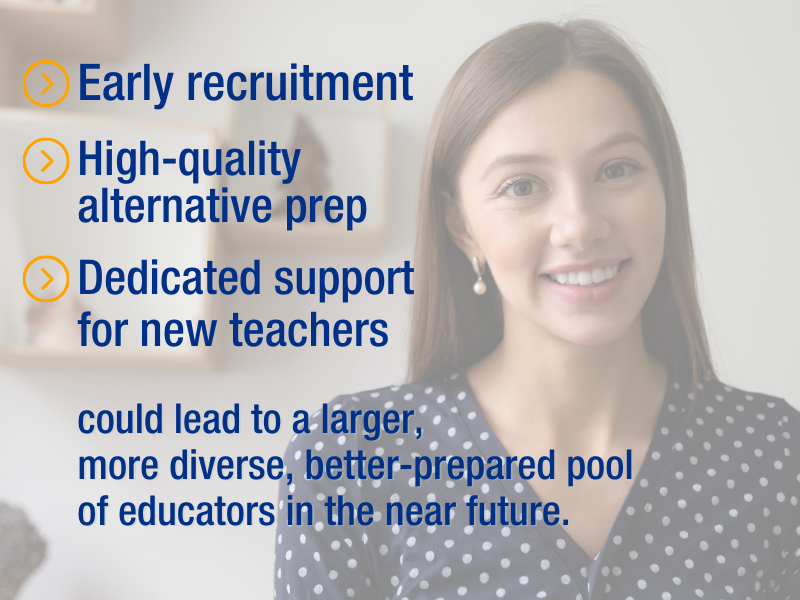 While these findings appear contradictory, we think it is possible that interest in teaching might have declined even more over this period had the introductory courses not been available.
While these findings appear contradictory, we think it is possible that interest in teaching might have declined even more over this period had the introductory courses not been available.
By taking introductory courses in teaching, some high school students may decide that the positive aspects of becoming a teacher, such as a desire to work with and impact young people, may outweigh the negatives, such as low salaries, student disciplinary challenges or lack of flexibility in the workday.
What high school students take away from these courses may also explain the increase in enrollment of Black, Hispanic and Latino students and the stable racial and ethnic diversity in both interest in becoming a teacher and in earning a teacher credential.
SREB’s Ideas for Progress
Since we see that many early career teachers formed their interest in teaching before entering high school, future research should explore whether taking introductory teaching courses increases or decreases the likelihood that young people with an early interest in teaching go on to become teachers.
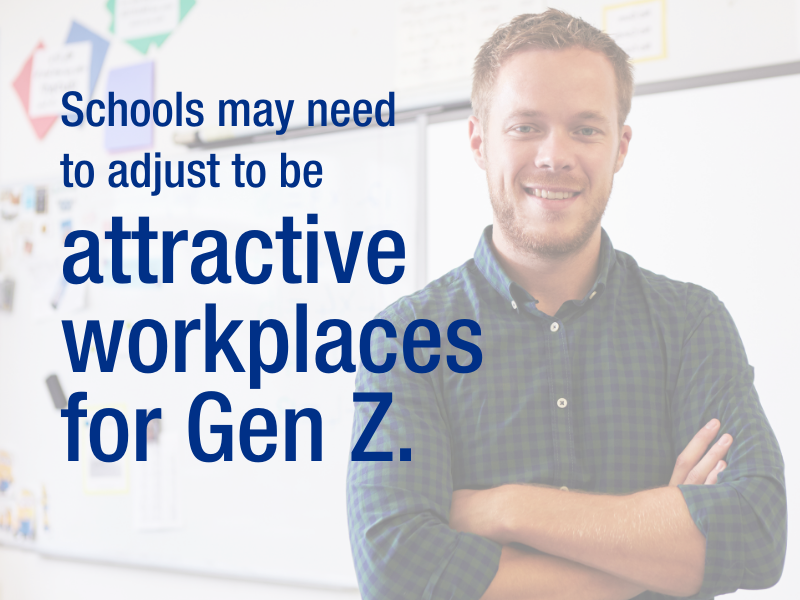 As salary, mentoring support, collaboration, flexibility and autonomy are all characteristics that Generation Z reports desiring in their career, schools need to adjust many of their historic structures and policies to be attractive workplaces for this generation.
As salary, mentoring support, collaboration, flexibility and autonomy are all characteristics that Generation Z reports desiring in their career, schools need to adjust many of their historic structures and policies to be attractive workplaces for this generation.
A stronger focus on quality teacher mentors, supportive induction programs that span the first few years of teaching, clear resources to assist with student discipline, emotional and behavioral needs, and career advancement pathways can help to respond to Generation Z’s needs and interests.
Which pathways are increasing the teacher workforce?
While the number of graduates from traditional teacher prep programs is declining, they are still the most sought after by schools for employment. And the numbers could increase with efforts to recruit early and improve the profession’s attractiveness.
Yet, data from the Tennessee Educator Survey suggest that a sizeable number of early career teachers decided on their career path after college —17% after receiving a degree in a field other than education and 27% after working in another occupation. Alternative preparation often serves the needs of this group of potential teachers, and completion rates for alternative programs are trending up.
SREB’s Ideas for Progress
This data suggests there is a continuing role for high-quality traditional and post-baccalaureate credential programs as well as high-quality alternative pathways, to address teacher shortages.
We see a high correlation between interest in an education career and intent to major in education, but not all high school students who plan to pursue a career in education plan to study education in college. This may be especially true for students who plan to teach at the middle and high school level.
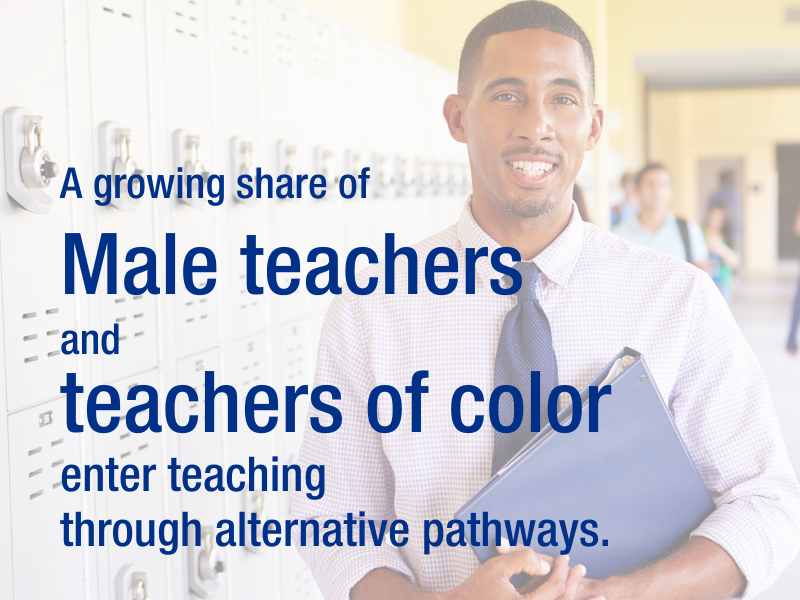 Males and people of color are more interested in other majors before pursuing a career in education, so we are more likely to continue to diversify the profession through alternative pathways.
Males and people of color are more interested in other majors before pursuing a career in education, so we are more likely to continue to diversify the profession through alternative pathways.
However, new teachers are increasingly critical of the preparation they received, so it is important that all teacher preparation and credentialing programs are rigorous, with supportive on-the-job training.
Does Generation Z see teaching as a viable career choice?
Members of Generation Z are largely guided by purpose and service, work-life balance and financial security when planning their career choices. Teaching meets drive for purpose but is not widely viewed by this generation as offering the balance and security they seek.
SREB’s Ideas for Progress
This study’s Gen Z interviewees provided several suggestions for education leaders and policymakers to improve the recruitment and retention.
- Teachers need more direct support from instructional leaders, as well as professional development to feel supported in their role.
- Policymakers need direct connections to teachers, to consider their feedback and be open-minded about constructive changes.
- Teachers say we need more public trust in their abilities to teach their subjects. Leaders can help enable a rebuilding of this trust.
- Teachers need more support for functional and safe classrooms, including strict policies for school safety and student smartphone usage.
- Salary and other incentives need to improve to attract new teachers as well as to retain those who are already in the classroom. These increases would support the “additional duties as assigned” that come with most teaching contracts.
- Teachers need more planning time or teacher workdays for planning, collaboration, development and balancing operational duties.
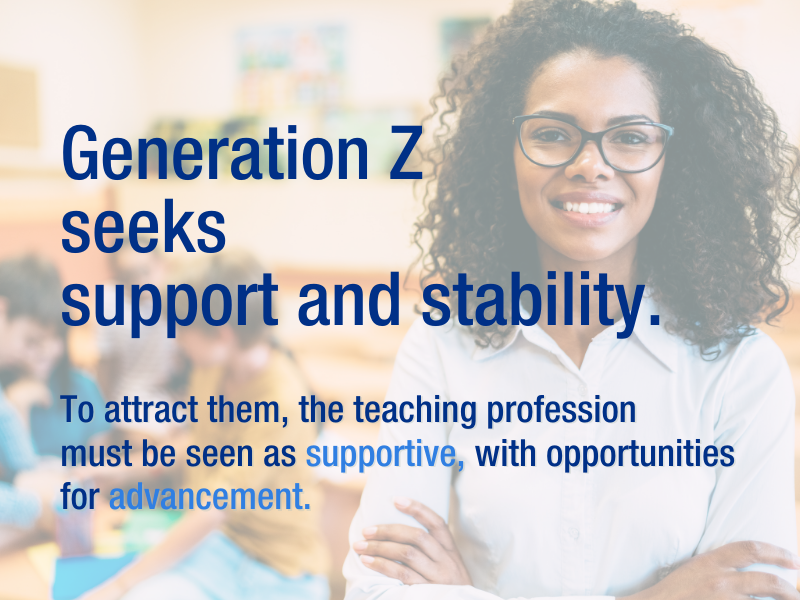 Gen Z entered or is entering the workforce during the onset or aftermath of the COVID-19 pandemic. They grew up in the aftermath of 9/11, witnessing the rise of the internet and smart phones, a major economic recession and a global pandemic. As a generation they are more diverse, innovative, adaptable, educated and tech-savvy, yet they experience higher rates of emotional distress about the future.
Gen Z entered or is entering the workforce during the onset or aftermath of the COVID-19 pandemic. They grew up in the aftermath of 9/11, witnessing the rise of the internet and smart phones, a major economic recession and a global pandemic. As a generation they are more diverse, innovative, adaptable, educated and tech-savvy, yet they experience higher rates of emotional distress about the future.
Overall, Generation Z seeks support and stability. To attract this generation into teaching, the profession must be seen as stable and supportive, with opportunities for advancement.
About this report
SREB led the qualitative research for this report, using qualitative case study methodology. SREB staff interviewed more than 20 Gen Z teacher candidates and newly hired teachers across five colleges and five urban, suburban and rural school districts in Kentucky and Tennessee in spring 2023.
The interviews and subsequent document collection focused on learning what influences Gen Z ’s desire to teach, what affects their practices and experiences in schools and classrooms, and what influences their decisions to remain in or leave the profession.
Interviewees were studying or teaching across a range of demographics, grade levels and subject areas, and including visual arts, history, biology, English as a second language, Spanish, physical education, career and technical education and therapeutic services. Most (61%) of the participants followed a traditional pathway to obtain their teaching certification and license, while the remaining pursued alternative certification programs or pursued additional degrees to become certified teachers.
Read the quantitative analysis working paper, with references and appendices, on the website of the Tennessee Education Research Alliance at Vanderbilt University.
This report was produced with support from the William and Flora Hewlett Foundation.
It was co-written by the Southern Regional Education Board and the Tennessee Education Research Alliance at Vanderbilt University.
Co-authors are Laura Neergaard Booker, executive director of the Tennessee Education Research Alliance and senior lecturer, Peabody College, Vanderbilt University; Ashley Ellison, graduate research assistant at the Tennessee Education Research Alliance, Peabody College, Vanderbilt University; Thomas Smith, professor of public policy and education, Peabody College at Vanderbilt University; Megan Boren, project manager at SREB; Sheniqua Pierce, research analyst at SREB; and Jessica Nadzam, research associate at SREB.
A companion article was published in the Peabody Journal of Education: From Student to Teacher: A Descriptive Examination of High School Students’ Interest in Teaching Professions
SREB and Vanderbilt University thank the Tennessee Department of Education, the Kentucky Center for Statistics (KYStats) and the Kentucky Department of Education for their participation. Additionally, we are grateful to various K-12 and higher education representatives from each state who provided feedback through the study’s research advisory committee.
Suggested citation: Booker, L., Ellison, A., Smith, T., Boren, M., Pierce, S., Nadzam, J. (2024). The Next Generation of Teachers: A Study of Generation Z’s Interest in the Teaching Profession. Southern Regional Education Board and the Tennessee Education Research Alliance at Vanderbilt University. https://www.sreb.org/publication/next-generation-teachers
The Next Generation of Teachers: A Study of Generation Z’s Interest in the Teaching Profession is licensed under CC BY 4.0


